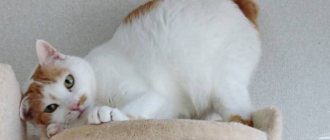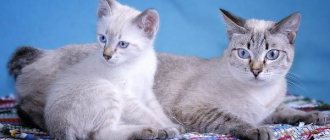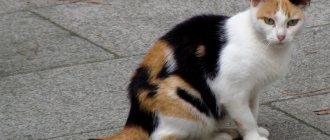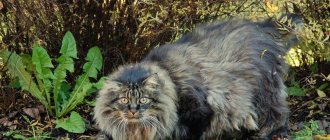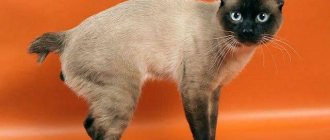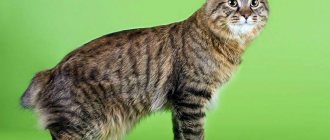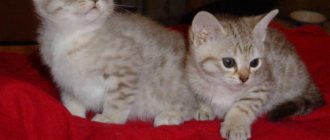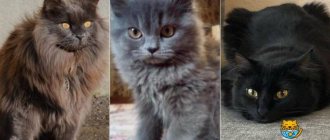Japanese cats with big eyes breed. ✅✅✅ Which cats are classified as Japanese breeds: photographs and description of the only breed recognized by canine associations, pictures of the cat, character, features of the content ➤➤➤
Japan is a country where there are a sufficient number of felinological clubs and cat lovers clubs. However, at the moment, only one breed of Japanese breeders has been officially accepted by international organizations of felinologists.
In this country, with its unique traditions and culture, the national flavor leaves its mark on all areas of life, including the species diversity of cat breeds bred here. The unique approach and original requirements for the exterior have led to the fact that the selection of cats here is narrowly focused.
Reasons for the uniformity of selection
In Japan, representatives of the cat world enjoy such respect, honor and exclusive rights that they cannot count on in any other country in the world. This special attitude towards cats is caused by culture and religious and ritual traditions passed down over many centuries.
According to local beliefs, the tail of any animal is a concentration of devilish energy, negativity and destruction. This was the reason that cats with long tails were not particularly popular, while representatives with short tails became inhabitants of the imperial palace. The rest of the cats were destined for a terrible fate: their furry source of pride was simply chopped off by people who wanted to limit themselves from negativity.
It was here that kittens without this organ began to be born. It is possible that such mutations in cats occurred everywhere, but only Japanese residents reacted with enthusiasm to this fact and began to take especially careful care of tailless animals, which was the beginning of narrowly targeted selection.
The trait quickly took hold and became the main anatomical feature cultivated in Japan. Since the country remained closed for a long time, the new standards did not make any changes, and the breed became increasingly established and rooted during crossings between similar specimens. The species is called the Japanese Bobtail.
Terms of use
A cat waving its right paw is needed for home, and its left paw is needed for work. Together they complement each other.
Money cat location
Most often, the figures are placed at the entrance to a house or shop. Different directions of the world enhance the characteristics of maneki-neko:
- location on the northeast side will attract wealth;
- a cat in the southeast corner, where the “knowledge zone” is located, will help you invest more wisely.
If the figurine is in the office, then it can be placed on the desktop. To enhance the effect, it is placed in a money pot, where coins should be poured. If the cat can move its paw, running on simple batteries or solar energy, you need to make sure that it does not stop.
Features of vision in cats with huge eyes
The special structure of the eye makes cats with huge eyes stand out among other predatory mammals. Big-eyed cat breeds are the peak of perfection. Thanks to their huge visual organ, they have a visual angle of 170-185 degrees, when in cats with normal eyes this angle is 160-169 degrees, but this is not small! In dogs, the field of vision is almost 2 times smaller.
The cutest big-eyed cats
Thanks to selection and random mutations, cats with big eyes exist not only in cartoons, but also in the real world. Many cats can boast an expressive look, but only some representatives of the whiskers have truly huge eyes. We invite you to meet the most big-eyed cats on the planet who have conquered the Internet:
- 1 place.
Cobby The black sheep of the cat world - this is how one can characterize the British Shorthaired Chinchilla. All representatives of the breed have a bluish-gray coat color, but Cobby is special. Snow-white fur combines effectively with huge sky-blue eyes. The black edging around the eyes gives incredible expressiveness to the look. Cobby has his own page on Facebook and Instagram. - 2nd place.
Gimo A rising Instagram star who is often compared to the Cheshire cat. Indeed, these cats have a lot in common! No matter what this cute cat with big eyes does, it is impossible to resist his hypnotic gaze of yellow eyes. Today Gimo has more than 160 thousand subscribers.
- 3rd place.
Snoopy Short-haired exotic cat Snoopy, one of the cutest cats with huge eyes. Snoopy is one of the most popular felines, with over a million subscribers! An innocent and even a little wise look perfectly complements the natural sense of smell. Many people who are poorly versed in felinology call representatives of short-haired exotics the “Snuppy breed.” - 4th place.
Cat Herman A very unusual big-eyed cat. Cat lovers have been arguing about Herman's mercy for a long time. Someone writes: “A cat like this can only scare people at night,” others believe that the cat is constantly surprised and frightened, while others dream of having such a pet nearby. Looking at Herman’s photos on Instagram, it’s hard to argue that he is unique. The cat has a distinct personality. His channel has more than 21.1 thousand subscribers.
Rare nicknames for cats
If the owner wants to give not just a name, but choose it with meaning, then for cats a Japanese name is what is needed.
Akio the cat
- Sisi - lion;
- Kaoru - a delightful fragrance;
- Taiki – glossy, sparkling;
- Hideki - who came up from the oak forest;
- Hiroaki – significant, extensive;
- Haruto is the sun in the sky;
- Itsuki – wooded tree;
- Kaito - soaring over the expanse of water;
- Kairi – beaver;
- Usagi – little bunny;
- Riku – universe;
- Koji – tiger cub;
- Gan is an untamed gander;
- Inoshishi – boar;
- Taka – merlin;
- Ondori – cockerel;
- Kumo – spider;
- Bata - cicada;
- Tomo - friend;
- Ani – older brother;
- Kita - Nord;
- Masaki – great tree;
- Utah - clear light;
- Akio – intense;
- Atsushi – hard worker;
- Dayaks - famous, huge, generous;
- Daisuki is a remarkable supporter;
- Hayate – smoothed;
- Nisi – sunset;
- Higashi – West;
- Kanxia – gratitude;
- Hitoshi – having a colossal goal;
- Kenshin – abstinent, inconspicuous;
- Kenta – rich, large, tall;
- Kiyoshi – neat, chaste;
- Gisin – fear;
- Genki – freshness;
- Kanraku – entertainment;
- Simpai - anxiety;
- Kanshin - admiration;
- Airen - compassion;
- Fuman - irritation.
Japanese exterior
Japanese cats have clear exterior requirements that they must meet:
- They are characterized by the genotype of the Japanese Bobtail and are directly related to it.
- Good health is a must.
- By color, the most common are bicolors with a predominance of white, calico and tortoiseshell-white. Only colorpoints and the Abyssinian phenotype are excluded.
- The key feature is taillessness.
It is important to know that the presence of heterochromia (different eye colors) in cats is a consequence of American selection, therefore such a representative cannot be classified as a Japanese breed.
The breed received its first recognition in 1976, when the Japanese Bobtail was officially listed by the CFA.
20 years later, another variety was recognized, the result of the work of Japanese breeders - the longhaired bobtail.
Shorthair Japanese Bobtail
The gene that is responsible for the main characteristics of this cat breed is in a recessive state, which means it cannot manifest itself when crossed with other breeds. Therefore, when buying such a kitten, you need to pay special attention to its pedigree.
Appearance
The body size of the Japanese Bobtail is average, the proportions are harmonious. Has a characteristic “samurai stance”, which is one of its notable features.
The cat's head is in the shape of an equilateral triangle and has an elegant muzzle. The ears are vertical and high set. The large oval eyes have an attentive expression; ideally, their color should be in harmony with the color of the coat.
The color is not variegated and is usually limited to two colors. The coat is single-layered, since there is no undercoat due to the fact that the origin of the species began in a mild climate. The cat does not shed intensely, so it does not cause severe allergies. The taillessness of the breed is somewhat exaggerated: in fact, the cat has a tail rudiment measuring from 2.5 to 7.5 cm. Thicker and longer hair grows on it, which forms something like a pompom.
Character
They have an easy-going character and a reputation for being affectionate cats. They are very active and love movement, but most of all they prefer those games that can be played with the owner.
The coat has good water resistance, so many cats of this breed love to swim in the bathtub or open water. Another feature is a wide range of sounds: these cats can reproduce various sounds from meowing to something similar to bird trills.
They need frequent attention from the owner, since such a cat, left alone for a long time, can show its protest in the form of dirty tricks: torn wallpaper, scratched furniture or overturned flower pots.
Health
Long centuries of street life, during which these cats were forced to catch mice and obtain food on their own, have led to the fact that Japanese Bobtails have excellent health and strong immunity. They rarely get sick from most feline diseases and recover quickly.
Kittens of this breed begin to walk and become independent much earlier than other felines, and their life expectancy is about 15 years.
Rare nicknames for cats
The names collected below are a godsend for fans of Japanese culture. An extraordinary name should be in harmony with the inner world of the animal.
Charming Amy
- Ai – lust;
- Aiko – beloved;
- Aki – autumn;
- Akiko – child of autumn;
- Amaya - rain in the night;
- Gina – silver;
- Katana - blade;
- Kin – saffron yellow;
- Sora – firmament;
- Takara – wealth;
- Chika – intelligence;
- Amy - sent down beauty;
- Haru – spring;
- Kusa – dense grass;
- Mori - grove;
- Nanami - seven seas;
- Tamiko is a beauty's child;
- Naoko – immaculate;
- Yumiko – beautiful;
- Rina – jasmine;
- Rio - sakura;
- Miki is a delightful princess;
- Naomi – charming, immaculate;
- Shiori - work;
- Reko – coolness;
- Sachiko – cloudless and festive;
- Hiroko – rich;
- Hisako – immortal;
- Mana – commitment;
- Manami - beautiful love;
- Mio - cherry tone;
- Moriko – child of the forest;
- Masa – truth;
- Hitomi – apple, eye;
- Hoshiko – star child;
- Shika – fawn;
- Asuka - a delicious fragrance;
- Yukari is a beautiful pear;
- Yuko is an affectionate child;
- Mao is the cherry in the wind;
- Mariko - born in a village;
- Hotaru – firefly;
- Izumi – spring streams;
- Toshiko – smart;
- Wakana – melodic consonance;
- Kamiko is excellent;
- Denko - lightning;
- Musume – daughter;
- Ane – sister.
Cat breeds with large, round, surprised eyes
Cats with different eyes - examples of what breeds are called
The shape and size of the eyes depends on what breed the animal belongs to. Some cats have such an unusual and beautiful look that it is simply mesmerizing.
Balinese cat
Representatives of this breed are very graceful, resilient and strong. Balinese have a fairly elongated body, paws, neck and tail. The tail is thin and pointed at the end. It is completely hidden by the animal's long hair.
The eyes of this breed are located slightly slanted, similar to the almond-shaped eyes of oriental beauties. Balinese cats do not have squints, bulges, or pale irises.
Balinese cat
Ukrainian Levkoy and other hairless cats
Hairless lefties have a flat, slightly elongated body. When viewed from above, it resembles a pentagon. These cats are unusual and attractive due to their prominent forehead.
Note! The eyes of these animals are slightly slanted, usually green or blue.
Ukrainian Levkoy
Devon Rex
These cats are not like other representatives due to their unique appearance. They are distinguished by huge ears and large eyes on a heart-shaped muzzle, a wide chest and long legs with an overall compact and light build. The unusual appearance, distinguishable even from afar, is complemented by short wavy hair, very fine and pleasant to the touch, which does not cause allergies.
Devon Rex
Japanese Bobtail
A goggle-eyed cat, like a cat of this breed, is distinguished by a lean, athletic and slightly elongated body with well-developed, but not massive, muscles. They are gracefully built, elegant and very harmonious, without unnecessary lightness, but not stocky either. The animals' heads are small, triangular in shape with curved smooth contours, giving the impression of being sculpted and sculpted. The breed has a soft rounded chin, high cheekbones, and well-defined whisker pads.
Bobtails have large, expressive oval eyes, set wide and slightly at an angle, which is especially noticeable in profile. They can be any color, but are usually golden yellow.
Note! Representatives of this breed are highly valued not only in Japan, but throughout the world. They are born with white fur with red or black spots.
Japanese Bobtail
Scottish Fold (Scottish Fold)
A cat with big eyes or a cat from this breed has a muzzle decorated with folded ears, giving the animal a sad and naive expression. This is a very friendly and affectionate breed, among other things, it is distinguished by its extraordinary intelligence.
Scottish lop-eared
Persian cat
The Persian big-eyed cat stands out among the breeds with its flattened muzzle. It seems that his face was specially flattened. Large eyes are round in shape. The standard allows for iris shades of blue, multi-colored orange.
In addition, cats with huge eyes have long, fluffy, soft fur that requires constant care. Representatives of the breed have a calm character. They are friendly and not aggressive. The Persians have a phlegmatic temperament.
Persian cat
Abyssinian cat
The big-eyed Abyssinian cat has a flexible and strong body with well-developed muscles. The animal's neck is extended. The paws are high and slender, which gives the breed gracefulness. The tail of this breed is long with a thickening at the base, tapering towards the edge.
The head is slightly elongated, with soft contours. The ears are large, set wide apart in different directions from each other. They always stand upright, wide at the base, rounded at the tips.
The animal has an attentive and intelligent look. The eyes of the breed are shiny, large, distant from each other, and predominantly green in color. This is a breed with short, but thick and fine hair that lies tightly to the body. It has a very beautiful and unusual color, evenly distributed throughout the body without additional patterns.
Note! Each hair of the coat has dark and light zones - ticking.
Abyssinian cat
Turkish Angora
This is a very elegant medium-sized breed with a flexible, elongated body, quite muscular and graceful. Cats are quite small in weight compared to cats. They reach no more than 3.5 kg, and big-eyed cats weigh 2 times more. The eyes of representatives of this breed are large, widely set, round, slightly slanted in shape. Most often they are blue, green or yellow, but there are also different colors.
Turkish Angora
Scottish Straight
Scottish Straights have a rounded head with a convex skull. Also a rounded muzzle and voluminous cheeks. The nose of animals is short, slightly arched at the transition to the forehead. The chin is round and strong. This is a breed with luxurious mustaches located on convex pads. The short neck is less powerful than that of the “British”.
Representatives of this breed have large, wide open eyes. They are most often blue or amber in color. The ears are widely spaced, medium-sized, with slightly pointed tips.
Scottish Straight
Top beautiful and popular nicknames
When naming your pet a Japanese name, you should take into account the pet's temperament, habits and origin. As a rule, such names are given to cats of exotic breeds. The names from the following collection are suitable for both boys and girls.
Baby Katsu
- Ayano - blooming silk;
- Asami - morning beauty;
- Aoi - blue-eyed;
- Aki - autumn time;
- Bara - rose;
- Gin - silver plated;
- Denko - lightning;
- Inari - the goddess of sword and rice, transforming into a fox, beautiful and cunning;
- Ioko - sea;
- Keiko - adored;
- Kohana is a miniature flower;
- Katana - sword;
- Masuru - fighter;
- Miwa - balanced;
- Mizu - water;
- Kiemi – pure beauty;
- Yoshiko – kind;
- Miyu is a gentle beauty;
- Katsumi is the winner;
- Kazuko is a child of harmony;
- Kasumi - foggy;
- Nariko - affectionate;
- Natsumi - delightful summer sun;
- Sashiko is the golden child;
- Shinsetsuna - kind-hearted;
- Sango - coral;
- Sakura - plum flower;
- Tomomi is a loyal comrade;
- Fumiko - preserving beauty;
- Haruki - brilliant;
- Hoshi is a star;
- Hane - orchid;
- Yuna - soft;
- Yusei - fairy;
- Yasu - serene;
- Akarui - hilarious;
- Akihiko is an exquisite prince;
- Asobu - flirtatious;
- June - pliable;
- Daikoku - god of luxury;
- Ichiro - first son;
- Kyoko - heavenly;
- Kimiko - aristocratic blood;
- Katsu - brave, winner;
- Kagutsuchi - lord of fire;
- Kyoko is a lucky guy;
- Kin - gold;
- Poppies - aspiration;
- Minaku - beloved;
- Mukuge - furry;
- Natsuko, Natsu - born on a summer day;
- Ozemu - sovereign;
- Ryota - powerful;
- Rekucha - green tea;
- Sin - genuine;
- Satoshi - reasonable;
- Takeo - warrior;
- Toru is a wanderer;
- Hideo - curvaceous;
- Chizay - miniature, tiny;
- Etsuko - child of joy;
- Yutaka - triumph;
- Yasushi - peace-loving, serene;
- Yau is a hero;
- Yasuo is truthful.
Longhaired Japanese Bobtail
This breed of cat also had other names: “Bobby” and “Chrysanthemum cat”, but it was officially recognized as the Japanese Longhaired Bobtail.
Appearance
Average body size, weight does not exceed 4 kg in large males. The body is muscular (not skinny). Due to the fact that the hind legs are longer than the short ones, this species has a specific uneven gait, with peculiar “jumps” of the rear part.
Unlike the short-haired modification, the long-haired ones do not have a flattened muzzle, but they do have a small depression at the transition from the forehead to the nose. The ears are set wide apart and may appear to tilt slightly forward when the cat is at rest.
The coat has an undercoat, but pronounced shedding occurs only in the spring and takes no more than 5-6 days. There may be a small “collar” of wool around the neck.
Character
The cat is very active and active, but unlike the short-haired cat, it is more jealous, so keeping it in a family that already has a dog or other pets is not worth it, as this can cause a sharp deterioration in its character. If she gets enough attention, she becomes a very gentle animal that adores her owners.
Health
Since this variety is a derivative of the original species, it is less resistant to various kinds of diseases. These cats must be fed with high quality ingredients. If you follow this rule, there will be no health problems.
Cats of these breeds are currently widespread only in Japan, and in the USA and Europe they remain quite rare and expensive, but their exotic appearance and wonderful character make them increasingly popular.
Geographic nicknames
Beauty Ashi
A melodious name can be chosen, inspired by the geographical name.
- Tokyo is the capital of Japan.
- Kobe is a city.
- Kawasaki is a densely populated metropolis.
- Kyoto is a centrally located city.
- Osaka is the largest metropolis.
- Fuji is a city located near Tokyo.
- Fushimi is the Japanese holy of holies.
- Ashi is a lake, a colorful pond.
- Oki, Okinawa is an island chain.
- Sapporo is a large city;
- Yokohama, Yoko is a city located near the capital.
Features of large eyes
The location and size of the eyes depend on the breed of the pet. Some cats have such unusual and beautiful eyes that their gaze is simply mesmerizing. Looking at them, you get the impression that you are communicating with a representative of another civilization. The expression “eyes are the mirror of the soul” applies to such cats in the most direct way.
Snow-white beauty
Experts assure that, regardless of the shape and size of their eyes, cats do not have three-dimensional vision and perceive their surroundings differently from humans. In addition, due to severe farsightedness, some pets may not even be able to discern what is going on under their noses.
Conventionally, the shape of cats' eyes is classified into 3 types:
- round;
- almond-shaped;
- slanted.
Breeds with the first two types boast large and expressive eyes. Cats with slanted eyes look more unusual and alien-like.
Attention! If you want to have a pet with a certain iris color, you should pay attention to the color of the kitten’s coat, which directly affects the color of the eyes.
Funny names
Many nicknames in Japanese sound funny to the Russian-speaking population. Based on this feature, you can choose a name for your pet.
Baby Gachi
- Kakashi Hatake;
- Taiga Aisaka;
- Smoker;
- Dororo;
- Boa Hancock;
- Site Manager No. 7;
- Umaru Doma;
- Gachi Mucho;
- Yolupukki;
- Pisa;
- Sicinho;
- Kogo Kaga;
- Aunt Sato;
- Iodo;
- Katyusha;
- Dear Daniel;
- Soul;
- Tuxedo Man;
- Fedor Dostoevsky;
- Korosensei;
- Hernia Solace;
- Truffle;
- Cocoa;
- Pokoten;
- Pikachu;
- Bullasaurus;
- Sasuke Uchiha;
- Accelerator;
- Olivie;
- Bunch;
- Gladiolus amicitia;
- Mori Jin;
- Dix Perdix;
- Fried shrimp;
- Donut Cat;
- Pie a la Maude;
- Potato.
Japanese Bobtail – a symbol of happiness and good luck
The Japanese Bobtail is a rare breed of cat that can only be purchased from the only certified cattery in the country. These cats are valued for their unusual tail structure, their mental ability, dexterity and friendliness.
In the article we will talk about the standard and nature of the breed, what to feed the Japanese Bobtail, where and how much to buy a purebred kitten.
History of the origin of the breed
This breed was developed in China and brought to Japan at least 10 centuries ago. According to history, Japanese authorities in 1602 ordered breeders to release cats of this breed outdoors to help fight rodents. After this, the sale and purchase of the Japanese Bobtail was prohibited by law. Due to this, these cats became strays and inhabited various farms. Elizabeth Freret first exported this breed outside of Japan in 1968.
At the moment, the Japanese Bobtail is classified as FEFe.
The most popular among breeders is the “mi-ke” coloring - a combination of black, deep red and white.
Breed characteristics
Standard
- Body: Medium size, thin but muscular, with pronounced curves. Weight is average, varies from 2.5 kilograms to 4 kilograms. The chest is powerful, the back has an even curve, and the bones are strong.
- Eyes: oval-shaped, large, set at an angle, yellow, blue, brown, aqua, gold and orange, depending on the color of the coat. Heterochromia (different eye colors) is especially appreciated.
- Ears: Large, erect, set wide apart and directed closer to the head.
- Head: wide, shaped like an equilateral triangle, cheekbones set high.
- Tail: it is the short tail that is the distinctive feature of this breed, and it is individual for each individual. Maximum length – 12 centimeters; can be pom-pom-shaped, curved, curled or straight.
- Limbs: proportional to the body, long, hind legs longer than the front, in a position convenient for jumping. Due to this, cats are particularly jumping.
- Coat: medium length, silky, longer on the tail, noticeably shorter on the muzzle, ears and paws; single-layer, has no undercoat. The long-haired Japanese Bobtail boasts a fluffy collar, tail, and mitted paws.
- Color: can be varied, but tri-color is greatly appreciated: a combination of white, deep red and black.
Differences between the Japanese Bobtail and the Kurilian
The main differences between the Kurilian Bobtail and the Japanese are the thicker and fluffier coat. If you look at the first representative of the felines, you can immediately see a stocky and strong body. At the ends of the ears you can see small tassels.
Kurilian bobtails can withstand cold weather, which cannot be said about Japanese ones.
Appearance of the Irimoto breed
The Irimoto cat has not reached the size of a cheetah; it is even smaller than a Pallas's cat - from 70 cm in length to a meter. We “separate” the short tail and get an animal barely larger in size than our domestic cat with a similar weight – 3-4.5 kg. There are Japanese wild cats weighing 5 or even 7 kg, but this is the privilege of those “Japanese” who are destined to live their lives in zoos. We will return to zoos later; this is a very important topic in our story.
Since the legs are short, the height at the withers of such a cat does not exceed 25-30 cm.
The color of the coat seems brownish-brown, however, only the guard hair is brown, the undercoat is dark gray. The amount of blood hair is not inferior to the amount of undercoat, hence the “increased” density of the coat and the general impression of a “dirty” coat. Small dark or black spots cover the entire cat, practically merging into uneven stripes and entire “islands”, which can be seen when the cat moves. There are 5-7 real black stripes stretching from the neck to the shoulders. The thick thick tail is rarely “ringed”, more often there are the same merged spots over its entire surface, the “balabashka” at the end is black.
The irimoto's muzzle is lined with exactly the same stripes that line the face of a cheetah - from the inner corners of the eye to the wings of the wide nose. It is believed that such stripes are a kind of “sight” for a predator, which is very helpful in hunting, but this gives the cats’ faces an unhappy, very sad look.
Here you can clearly see not only the “unhappy” appearance of the zoo pet, but also the large wide head, rounded ears, fuzzy stripes on the neck going down to the paws and the large, slightly bulging eyes of the nocturnal predator.
Health
The average life expectancy varies from 13 to 15 years, but long-livers of 20 years of age are not uncommon.
This breed is considered generally healthy, with only occasional skeletal defects in kittens. The short tail of the Japanese Bobtail is a genetic mutation, but does not carry with it any other defects or mutations.
One of the characteristics of kittens is their different eye colors, namely one is blue and the other is yellow. This is mainly characteristic of individuals with white coat color. Such a kitten is more likely to be deaf.
How to make your own talisman
You can create a figurine with your own hands from polymer clay or papier-mâché. It doesn’t matter what material Maneki Neko is made of, be it yarn or felted wool, the main thing is the mental attitude, and the cat figurine will definitely bring good luck to its owner.
As proof of your warmest feelings, you can give such a talisman to a loved one, thereby warning against failure and attracting good luck. The main condition is positive thoughts when creating a powerful amulet with your own hands.
Personality of the Japanese Bobtail
Cats and cats of this breed are distinguished by their mental ability, activity and playfulness. The active abilities of small individuals are compared to a natural disaster, but very neat and with a slow action. They love friendly communication with their relatives, as well as with people, which can be expressed either by a quiet purr or turn into a loud meow.
Due to their activity, these cats will not bask in your arms for a long time, but will try to explore every corner and find themselves playing. What is noteworthy is that they are interested not only in special toys, but also in outdoor activities. This feature also helps individuals quickly learn skills. They may start bringing you slippers or learn to walk on a leash.
They are natural hunters, so they can run and jump quickly. Of course, not without the help of the peculiarities of their hind legs. But this temperament does not prevent them from being very loyal to their owner and getting along well with children and dogs.
The Japanese Bobtail lends itself very well to training and learning commands.
Important! Your pet should have one trainer, because it gets used to the voice and will only listen to one person. Don’t forget about regular training and encouragement.
Disadvantages include their self-confidence and persistence. They decide for themselves what to explore. It is worth highlighting that due to its activity and hunter's instinct, the cat will not mind catching a rodent or bird, so walking on a leash is recommended. If you have small pets at home, keep an eye on them.
Video about the breed:
Wool
It is worth noting the cleanliness of the breed, which allows you to rarely bathe your pet, as he can cope on his own. During shedding, it is recommended to brush the coat regularly to prevent tangling. The rest of the time, just comb it once with a comb.
You should wash your pet no more than once every few months. If your cat walks outside and then comes into the house, wipe your pet's paws with a damp towel.
Nutrition
For bobtails, you need to choose food only of super-premium class and higher, since they contain a balanced content of essential microelements. Calculate the portion per day from the ratio of 80 kilocalories per 1 kilogram of weight. Cats do not suffer from excess weight due to high activity.
Our article can help you with the selection of wet food - rating of wet food for cats. If you have not yet chosen the type of food for your Japanese Bobtail kitten, then go to the article “Choosing premium and super-premium food for kittens.”
Note! Japanese Bobtails are very selective in food, so they will not eat food they do not like.
Ear care
Please pay attention to special recommendations for ear care. They have a specific structure, so dirt and secretions accumulate in them. If you don’t clean them on time, serious inflammation will begin.
Usually the claws get worn down on the floor surface and scratching posts, but a preventive inspection won’t hurt. Long claws may begin to curl, making it painful for cats to walk. In this case, they need to be cut.
Walking your pet
It is very difficult to get this breed to walk on a leash, as due to their activity and curiosity, they try to study everything thoroughly.
In small apartments, the Japanese Bobtail feels constrained; the ideal place to keep a representative of this breed is a private house with a garden. This way, the pet will be able to explore the area near the house and help in the fight against rodents, because the Japanese valued these cats for their hunting skills.
Care
Caring for a bobtail is very easy. They quickly adapt to life in an apartment or private house, characterized by an unpretentious disposition and minimal requirements for comfort. The only thing that needs to be provided to the animal is freedom of movement.
You can’t lock a cat in a room because he will start ruining things out of boredom.
Hygiene
Hygiene is simple:
- It is enough to thoroughly comb a short-haired pet once a week. For long-haired breeds, it is better to use a comb 2-3 times a week.
- Eyes and ears should only be cleaned when they become dirty. To do this, simply moisten a cotton pad with warm water or chamomile decoction.
- It is necessary to bathe the animal rarely so as not to disrupt the level of skin hydration. This can be done in case of severe contamination.
Health
The cat has no abnormalities other than a shortened tail. She has a strong immunity to other ailments, and with regular vaccinations and proper care, the animal will feel good. The tail also does not cause developmental abnormalities over time and does not cause disease.
Breed card
| Characteristics of a cat | Notes | |
| General information | The breed is not widespread outside Japan, but is least common in Europe. | An ancient breed of cats |
| Character | Calm, friendly disposition. A playful and active cat that gets along well in families with children | “Talkative” cats. They are highly trainable and can learn to fetch small objects. |
| Appearance | Characteristic shortened tail, straight curve of the back. Color: bicolor and calico; the most valuable color is “mi-ki” (tortoiseshell-white cats). | |
Types of mascot
A white cat raising one paw brings intellectual development, helps maintain mental balance and a positive attitude.
A royal cat holding a gavel and wearing a scarf is suitable for executives. The items symbolize good luck and prosperity.
The warlike Maneki-neko , dressed in a kimono and with kittens around, protects the owner from harm and disease. The more kittens, the stronger the symbol itself.
The black figurine protects against the evil eye, damage and evil spirits and calls upon good forces.
The red figurine wards off illness and negativity, attracts positive energy, and helps restore strength.
Blue - identified with chastity and morality, but has a beneficial effect on spiritual development and helps to cope with internal emotions.
A pink cat relieves loneliness, makes its owner more attractive and confident, and relieves melancholy. Increases attraction and attraction. Helps you find new relationships or strengthen old ones.
Green – has a positive effect on memory, concentration, and increases creativity. Suitable for students and creative people.
Money Maneki-neko , which holds a coin or a bag, helps to maintain and increase financial status. A cat with two raised paws protects the house . If mice sit on his lap, this means fertility.
If both paws of a cat are raised , this is a talisman for preserving the hearth and family happiness. If a cat with kittens is a symbol of fertility.
The objects the cat is holding have different messages:
- the fan drives away evil spirits;
- a children's toy makes wishes come true;
- a gold coin or fish - for money;
- a flowering twig attracts love;
- fruits lead to the birth of a baby;
- oar - success in any endeavor.
How to choose a bobtail kitten
Kittens are very active, develop quickly and can exist independently already in the third week of their life, but they are sold, like everyone else, starting from 3-4 months.
The cost of one pet is quite considerable, starting from 30,000 rubles. This price may vary depending on the gender, characteristics of the kitten, its class and pedigree. If you are going to buy it secondhand from a breeder, then no one will give you a guarantee of purebredness without a certificate. The most expensive kitten will be a girl with a tortoiseshell (tri-color) color.
Unfortunately, there are very few certified nurseries. In our country there is the only nursery - Headquarters-Captain Rybnikov. The main nurseries are located in Japan.
Famous anime cats
For fans of animated films - anime - the scope for imagination is enormous. You can name your pet after your favorite character who has similar character traits.
- Ichigo;
- Rukia;
- Hichigo;
- Orihime;
- Yasutora;
- Kisuke;
- Jushiro;
- Nemu;
- Kenpachi;
- Kusadzisi;
- Aizen;
- Momo;
- Soi Fon;
- Luffy;
- Sanji;
- Nico Robin;
- Naruto Uzamaki;
- Kakashi Hatake;
- Choumei;
- Gyuki;
- Saiken;
- Matatabi;
- Deidara;
- Tenten;
- Sasori;
- Inuzuka Kiba;
- Haku;
- Zabuza Momochi;
- Yamato;
- Shikamaru;
- Uchiha Madara;
- Conan;
- Gaara;
- May;
- Might Guy;
- Nagato;
- Evergreen;
- Kildhurst Clive;
- Lissana Strauss;
- Elfman;
- Charlie;
- Happy;
- Mirajane;
- Glitch Eye;
- Lucy;
- Elsa Scarlett;
- Gajeel Redfox;
- Juvia;
- Loki;
- Igneel;
- Minerva;
- Zeref;
- Freed Justin;
- Cana Alberona;
- Wendy Marvel;
- Kirito;
- Asuna;
- Zaza;
- Lisbeth;
- Konno Yuki;
- Silica;
- Quinella;
- Steal;
- Alicia;
- Nori;
- Argo;
- Keita;
- Eugeo;
- Kirigaya Midori;
- Recon;
- Koper;
- Kibao;
- Godfrey;
- Solterina;
- Diabel;
- Skuld;
- Endo;
- Sailor Moon;
- Tsukino Usagi;
- Sailor Mars;
- Hino Ray;
- Sailor Baby;
- Chibi-moon;
- Chiba Mamoru;
- Sailor Venus;
- Aina Minakopro.
Of course, these are not all possible nickname options. What names for cats do you associate with Japanese culture? Do you already have an idea what to name your pet? Share why you chose a Japanese name.
Breeding
Since the breed is difficult to access in Russia due to the small number of nurseries, it is difficult to find individuals for breeding. Japanese bobtails are of interest to an increasing number of Russians, but it is difficult to find a purebred Japanese rarity in our country.
You can note the basic rules. Since the breed is not whimsical, it has no concessions in its range. But it should be remembered that it is still worth carrying out selection in order to obtain purebred offspring that will not only vaguely resemble a Japanese figure.
Important! If you cross a Japanese Bobtail with another breed, the offspring will have a standard tail.
The call to mating in this breed is not accompanied by heart-rending screams. Instead they make trouble. It is also worth noting that the bobtail itself is an excellent and caring mother.
3-4 kittens are born in one litter, the mortality rate of which is very low. When crossing a Japanese Bobtail with a long-tailed breed, offspring with a long tail are born.
Feng Shui placement of the figurine
Usually the amulet is installed near the front door, and the money cat must always look towards the house, attracting good luck and symbolizing hospitality.
- If you place a cat near the cash register, this will definitely affect the increase in revenue.
- Sometimes you can see the amulet on a red rug in cafes and restaurants. An additional accessory enhances the effect of the talisman. The rug can be replaced with a regular piece of red fabric.
- If a cat waving its paw is standing on a work desk, then the cat’s face turned towards the owner will attract good luck and prosperity.
- Finding the talisman in the northeast promotes the perception of the flow of knowledge and successful management of finances.
- A figurine located in the southeast activates the money zone and increases material wealth.
- To enhance the effect of the talisman, the cat can be placed on a pot of coins. Thus, the energy symbolizing good luck will increase.
- For those who are looking for their soul mate, it is recommended to buy two cats at once with different raised paws.

